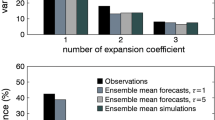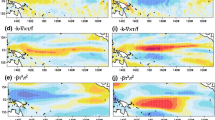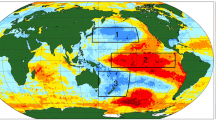Abstract
In Part I (Storch and Xu 1990) the principal oscillation pattern (POP) analysis of 200 mb equatorial velocity potential leads to the definition of a bivariate (POP-) index of the tropical 30- to 60-day oscillation. Using the POP prediction scheme this index is predictable for a few days in advance. In Part 11, the prediction of the equatorial velocity potential field, made by the POP method and made by two GCMs, is investigated. The POP index forecast can incorporate skillful forecasts of the equatorial velocity potential (χ) field. Its ensemble correlation skill score passes the 0.50 level at 7 days, whereas persistence passes after 3 days. If there is a strong 30- to 60-day oscillation signal in the initial state, useful forecasts of more than 20 days are sometimes possible; if the initial signal is weak, the POP forecast fails. Also, the forecast skill of two GCMs is considered. The NCAR T31 GCM appears to be quite skillful in predicting the equatorial χ-field, and in particular the 30- to 60-day oscillation. Its skill, however, is less than that of the POP scheme. The CNRM T42 GCM seems not to be able to predict the regular development associated with the tropical 30- to 60-day oscillation. The power of the POP index in explaining the equatorial x-field is a measure of the strength and dominance of the 30- to 60-day oscillation. This measure at day 0 is an a priori indicator of the NCAR T31 GCM's skill in predicting the equatorial velocity potential field.
Similar content being viewed by others
References
Baumhefner DP (1989) Prediction of forecast skill using Monte Carlo ensembles of 30 day forecasts. Proc. 14th Climate Diagnostics Workshop, Climate Analysis Center, NMC/NWS/ NOAA, WWB Building 606, 5200 Auth Road, Washington DC 20 233
Blumenthal MB (1991) Predictability of a coupled ocean-atmosphere model. Submitted to J Climate
Coiffier J, Ernie Y, Geleyn JF, Clochard J, Hoffmann J, Dupont F (1987) The operational hemispheric model at the French meteorological service. J Meteor Sec Japan, special NWP symposium volume: 337–345
Geleyn JF, Bougeault P, Rochas M, Cariole D, Lafore JP, Royer JF, André JC (1988) The evolution of numerical weather prediction and atmospheric modelling at the French weather service. J Theoretical Appl Mech 7:87–110
Hasselmann KH (1988) PIPs and POPs: the reduction of complex dynamical systems using principal interaction and oscillation patterns. J Geophys Res 93:11015–11021
Knutson TR, Weickmann KM, Kutzbach JE (1986) Global-scale intraseasonal oscillations of outgoing longwave radiation and 250 mb zonal wind during Northern Hemisphere summer. Mon Wea Rev 114:605–623
Madden RA, Julian PR (1972) Description of global scale circulation cells in the tropics with a 40–50 day period. J Atmos Sci 24:1109–1123
Murphy AH, Epstein ES (1989) Skill scores and correlation coefficients in model verification. Mon Wea Rev 117:572–581
Storch H v, Bruns T, Fischer-Bruns I, Hasselmann KH (1988) Principal oscillation pattern analysis of the 30- to 60-day oscillation in a general circulation model equatorial troposphere. J Geophys Res 93:11022–11036
Storch H v, Weese U, Xu J (1990) Simultaneous analysis of spacetime variability: principal oscillation patterns and principal interaction patterns with applications to the Southern Oscillation. Z Meteor 40:99–103
Storch H v, Xu J (1990) Principal oscillation pattern analysis of the tropical 30- to 60-day oscillation. Part I: definition of an index and its prediction. Clim Dyn 4:175–190
Trenberth KE, Olsen JG (1988) Evaluation of NMC global analyses: 1979–1987. NCAR Technical Note NCAR/TN299 + STR
Weickmann KM, Lussky GR, Kutzbach JE (1985) Intraseasonal (30–60 day) fluctuations of outgoing longwave radiation and 250 mb streamfunction during northern winter. Mon Wea Rev 113:943–961
Tribbia J, Baumhefner DP (1988) Estimates of the predictability of low-frequency variability with a spectral general circulation model. J Atmos Sci 45:2306–2317
Xu J, Storch H v (1990) Predicting the state of the Southern Oscillation using principal oscillation pattern analysis. J Climate 3:1316–1329
Author information
Authors and Affiliations
Additional information
The National Center for Atmospheric Research is sponsored by the National Science Foundation
Rights and permissions
About this article
Cite this article
von Storch, H., Baumhefner, D.P. Principal oscillation pattern analysis of the tropical 30- to 60-day oscillation. Climate Dynamics 6, 1–12 (1991). https://doi.org/10.1007/BF00210577
Received:
Accepted:
Issue Date:
DOI: https://doi.org/10.1007/BF00210577




